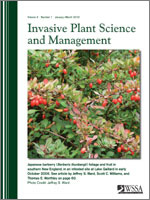As Europeans colonized California, they introduced annual grasses from the Mediterranean Basin. These exotic annual grasses eventually invaded grasslands throughout the state, some of which were once dominated by native perennial grass species. Annual grasses differ from perennials in their phenology, longevity, rooting depth, litter chemistry, and interaction with the microbial community. As these traits may influence plant nitrogen (N) use, it is likely that the invasion by annual species resulted in changes in the availability and cycling of N in California grassland systems. We addressed the question of how invasive annual grasses influence rates of N cycling by measuring N pool sizes and rates of net and gross mineralization and nitrification, gross immobilization, and the denitrification potential of soils from experimentally planted annual and perennial-dominated grasslands. With an increase in annual grass cover, we saw increases in ammonium ( ) pool sizes and rates of N mineralization, nitrification, and denitrification in soils. These differences in N status suggest that N cycling in California grasslands was altered at sites where native perennial bunchgrasses were invaded by nonnative annual grasses. One consequence of annual grass invasion may be a legacy of
) pool sizes and rates of N mineralization, nitrification, and denitrification in soils. These differences in N status suggest that N cycling in California grasslands was altered at sites where native perennial bunchgrasses were invaded by nonnative annual grasses. One consequence of annual grass invasion may be a legacy of  -enriched soils that hinder the reestablishment of native perennial grass species.
-enriched soils that hinder the reestablishment of native perennial grass species.
How to translate text using browser tools
1 January 2010
Invasive Grasses Increase Nitrogen Availability in California Grassland Soils
Sophie S. Parker,
Joshua P. Schimel
functional group
invasive species
Nitrogen mineralization





